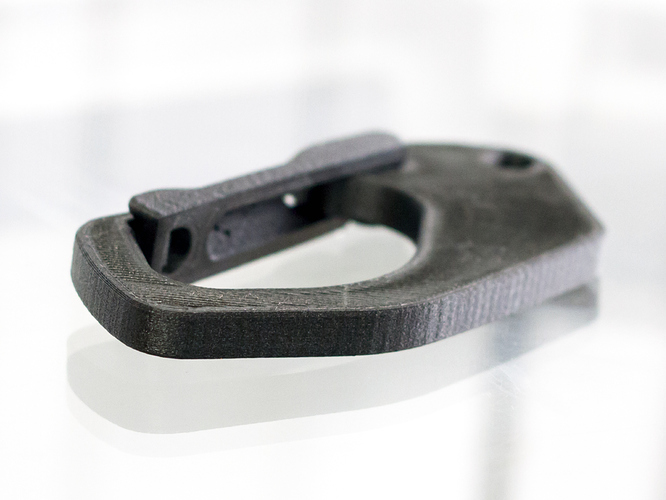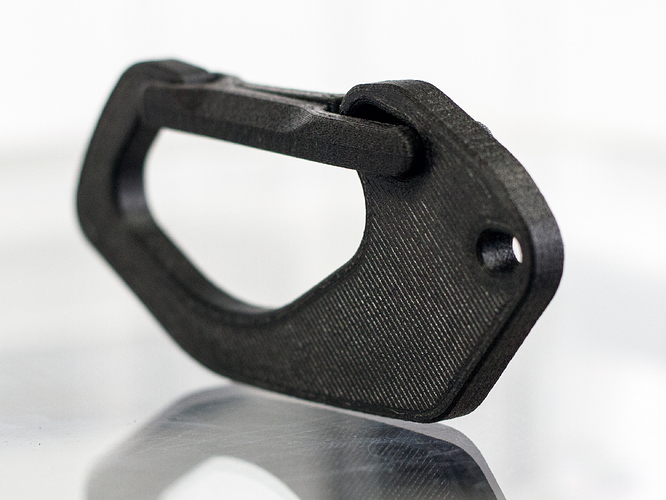As promised, macro shots of the CF Nylon filament… strength tests will be performed next week.
Where did you get this filament from, if you don’t mind me asking?
You’re going to test it against non-CF nylon from the same manufacturer, right? It’s probably going to break more easily because the fibers are too short to add strength and only manage to create weak points in the base polymer around themselves.
That matte finish is nice though.
We’re going to do a load test on a bunch of different carabiners. I don’t have any raw nylon from this mfg yet, but we’ll get some. I do, however, know what material it is, and there are some nylon filaments that are very similar. The more interesting thing, in my opinion, will be how strong it is compared to other filaments.
But yes, the finish is excellent. Very nice.
@denix We (MatterHackers) should have it for sale in a few weeks. Don’t have final pricing yet, but I expect it to be in line with other CF filaments.
The only thing that really matters is how it compares to filaments that are as similar as possible, but without the carbon fiber. CF is murder on the brass nozzles most people use, worse than metal-filled plastic according to the reports I’ve heard. If this filament isn’t stronger than the same base polymer without the CF, then the only reason to print it is for aesthetics (much like metal-fill).
How are you going to test the strength of the part? I guess you will print a set of carabiners, then add hanging weights to each of them until they fail, and take the average…?
But it would be nice to know how the strength of carbon-fibre nylon compares to the nearest rival - CF-PET-G.
Its just that I would rather print with PET-G than nylon, and if PET-G comes a close second then it makes sense for me to use that instead.
@Whosa_whatsis Scientific testing has shown that when the longer carbon fibres are aligned in the polymer matrix there can be a dramatic increase in tensile strength (along the grain axis) compared to the polymer alone, as well as a significant increase in mechanical stiffness (across the grain axis).
Ref: http://www.substech.com/dokuwiki/doku.php?id=carbon_fiber_reinforced_polymer_composites
That doesn’t mean that the CF filament will be better that just the plain polymer - testing printed parts still needs to be done to verify the theory.
We have a block and tackle with a 7:1 ratio and a rather precise force tester. Haven’t figured out the exact mounting yet, but we’ll attach the carabiner and apply load until it breaks and/or bends enough to come apart.
@Paul_Gross Just glanced over your link, but it appears to be talking about real composites with fibers running the length of the part.
Nobody’s disputing the strength of those, but in order to print material that already has the fiber embedded in a run-of-the-mill 3D printer (i.e. not something like the Markforged machine), those fibers have to be so short that they don’t make the material function as a composite, and instead act as nothing more than impurities in the base polymer.
@Whosa_whatsis fair enough, the link was a bit brief.
Here is a better one, linked from that one:
The theory goes that once the embedded fibres are long enough to overlap each other then they can reinforce the polymer matrix, leading to some benefit. The extent of the benefit can be estimated, but there is nothing like empirical testing to see if the resulting parts are actually stronger or stiffer.
Using 1.75mm filament should, in theory, allow a composite with embedded fibres long enough to overlap when aligned and provide some increase in mechanical strength and stiffness.
Of course, I imagine that fibres that are too long will not print very well…
CF and fiberglass composites are stiffer, lower-warp, and more dimensionally stable than the equivalent plain resin. That can be useful way to modify the properties of warpy, filaments like PP or filaments with poor dimensional stability like nylon. But you have to get the fibers properly bonded to the base resin or they will act as fracture initiation sites. From the data I’ve seen, most of the CF filaments are failing at that, and end up weaker.
@Ryan_Carlyle yeah - my concern is that manufacturers will not bother to go through the R&D effort to consistently delver a composite that ends up with the real-world benefits that are theoretically possible with carbon-fibre reinforcement.
On the other hand, a manufacturer that puts the effort into determining the fibre lengths and ratios that can be reliably printed to make a stronger resulting part, and then makes sure that their product can be repeatably produced at an acceptable quality standard, should capture a significant market share - the market being those of us who want to print mechanically strong and reliable parts on our 3d printers.
The rest of the manufacturers will probably just throw in a bit of carbon fibre dust and demand a premium price for a substandard product. They will quickly get a reputation for producing rubbish.
But I cannot speak to the size of that market. I am very keen to buy a filament with extra strength and reliability, especially if it is PET-G based, but I don’t know who else cares as much as I care.
@Paul_Gross Yep. But why PETG based? It’s already in a pretty good place for warping, strength, stiffness, and printability. The main value of this kind of chopped-fiber composite (where you can’t get really long fibers) is to overcome the limitations of the base materials. If you want “PETG but stiffer/stronger” then polycarbonate printed in a suitably hot environment will do the trick. Personally, I think CF-ABS is the way to go. The carbon fiber makes it significantly lower warp, so it’s not particularly hard to print (unlike ABS or PC) and you keep the high temp rating. (People who mix CF into PLA are missing the point in my opinion – why make a low-warp, stiff, brittle filament lower-warp, stiffer, and more brittle?)
Have you printed XT-CF20 from Colorfabb? XT is a PETG-class material.
@Marcus_Wolschon A couple different vendors have sent me datasheets or their internal test reports. I won’t mention names, but a couple examples:
CF-PLA
Tensile yield 50 MPa (base resin 56)
Elongation at break 1.88% (base resin 3.3%)
Tensile modulus 4711 MPa (base resin 2865)
Izod notch 0.58 ft-lb/in (base resin 0.47)
Izod no-notch 3.32 ft-lb/in (base resin 3.78)
CF-ABS
Tensile yield 36 MPa (base resin 41)
Elongation at break 1.75% (base resin 4.03%)
Tensile modulus 3458 MPa (base resin 1948)
Izod notch 0.68 ft-lb/in (base resin 3.63)
Izod no-notch 2.68 ft-lb/in (base resin 8.33)
Explanations for the non-engineers:
- Yield strength should be pretty clear.
- Elongation at break is an indication of ductility/toughness/brittleness. Higher is tougher.
- Tensile modulus is stiffness.
- Izod notch is (roughly) how hard it is to break if it has a sharp corner or damage to concentrate stress. Higher is tougher.
- Izod no-notch is how hard it is to break without any stress concentrations. Higher is tougher.
This is all as-printed data. So you can see a small loss of yield strength, significant loss of ductility, greatly increased stiffness, mininimal affect on PLA’s toughness (since it’s already brittle) and significant impact on ABS’s toughness (making it brittle like PLA).
A few notes to make about this data:
- The ABS base resin used here was already on the very brittle end of the range for ABS. The elongation and Izod of the base resin are both pretty low to start with. Could be a high acrylonitrile content and low butadiene content. Or, the print conditions may have weakened it (ie printing too cool or too fast).
- We have no idea whether the manufacturer did anything special to get the plastic to stick to the fibers. That could make a big difference.
- At first sight, PLA looks stronger (higher yield) than ABS. That’s only true for short load durations. PLA creeps to ultimate failure at room temp, which means it will crack (after days to months) at much lower stresses than the rapid tensile test indicates. Very few people actually test polymers properly… if you treat them like metals, you get misleading answers sometimes.
@Ryan_Carlyle The reason I prefer to stick with PET-G is that I don’t yet want to go through big changes to my current printer setup, which is:
Standard Printbot Simple Metal with UBIS hot end, cold bed and original brass nozzle.
It prints PLA very, very well, and I am so-far having good results with PET-G, but I am still new to PET-G.
In any case I will have to switch to a toughed nozzle to print carbon fibre filaments - probably a case-hardened stainless steel nozzle I saw very recently.
Beyond the nozzle change, I am hoping that I don’t have to make any hardware changes to print carbon fibre reinforced PET-G.
To modify my Printbot to print nylon seems like a much bigger issue - an new all-metal hot-end and a heated bed and new power supply to handle the extra load.
I am prepared to make changes to print carbon fibre reinforced filaments, but I really want empirical data on the benefits before I do a lot of changes.
So - thanks for the data on the CF-ABS and CF-PLA. That’s not an encouraging set of specs so far.
I do hope someone can manufacture CF-PET-G with much better specs that that.
I have a host of test T beams I have made in different base and filled materials that I have not tested yet. Need to get on to it sometimes. The 3DXtech CF PETG is appears much more difficult to bend than the base materials. I have pretty much stopped using PLA as its HDT are not suitable for much of anything especially when PETG is available and does not have the stench of ABS. I use a hardened nozzle on my setup as I knew I wanted to test a few of the filled materials. PC to me has its own setup of issues. Though I do have a test beam in it as well as Titan and another ABS/PC material.
@Paul_Gross you don’t need a heated bed for nylon. It sticks great on cold Ultem with glue stick. The mark forged machine is a nylon only machine and it’s$13k… no heated bed.
You don’t need the ultem if you’re putting gluestick on top of it 

